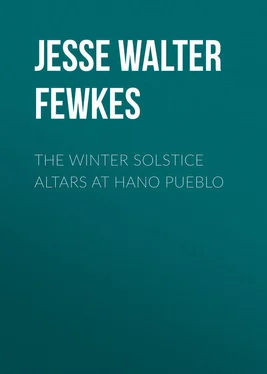Конец ознакомительного фрагмента.
Текст предоставлен ООО «ЛитРес».
Прочитайте эту книгу целиком, купив полную легальную версию на ЛитРес.
Безопасно оплатить книгу можно банковской картой Visa, MasterCard, Maestro, со счета мобильного телефона, с платежного терминала, в салоне МТС или Связной, через PayPal, WebMoney, Яндекс.Деньги, QIWI Кошелек, бонусными картами или другим удобным Вам способом.
The Winter Solstice Ceremony at Walpi ( American Anthropologist , vol. XI).
These studies were made under the auspices of the Bureau of American Ethnology.
Most of the people of Sitcomovi are of the Asa and Honani clans, of Tanoan ancestry, but they long ago lost the Tewa language and their Tanoan identity.
The site of this last settlement of the Patki people, before they joined those of Walpi, is in the plain about four miles south of the East Mesa. The ruins of the pueblo are still visible, and the foundation walls can readily be traced.
The Hano names of these pueblos are – San Juan, – ; Santa Clara, Kap'a ; San Ildefonso, Pocuñwe ; Pojoaque, P'okwode ; Nambe, Nûme ; Tesuque, Tetsogi . They also claim Taos ( Tawile ) and Picuris ( Ohke ), but say that another speech is mixed with theirs in these pueblos.
The Tewa of Hano call the Hopi Koso , and the Hopi speak of the Hano people as the Towa or the Hanum-nyûmû . The word "Moki," so constantly used by white people to designate the Hopi, is never applied by the Hopi to themselves, and they strongly object to it. The dead are said to be moki , which enters into the formation of verbs, as tconmoki , to starve; tcinmoki , to be very lonesome, etc. The name Hano or Hanoki is, I believe, simply a combination of the words Hano and ki , "eastern pueblo." The element hano appears also in the designation for American, Pahano , "eastern water"; pahanoki , "American house." Both the Asa and the Tewa peoples are called Hanum clans.
Remains of old reservoirs, elaborately walled, from which water was drawn by means of a gourd tied to a long pole, are still pointed out near Tukinovi and are said to have belonged to the Pe-towa . Old Tcasra claims that they were in use in his mother's grandmother's time.
The troubles following the great rebellion of 1680 drove many Tewa from the Rio Grande valley to Tusayan.
It is impossible to make this enumeration accurate, hence these numbers must be regarded as approximations.
It is not unusual to find several names applied to the same person. Thus, Hani, the chief of the Piba clans at Walpi, is called Lesma in the Snake kiva. The Walpi call the author Nakwipi, but the Flute chief at Cipaulovi insists that his name is Yoyowaiamû, which appellation was given when the author was inducted into the Flute rites at that pueblo in 1891.
The gap in the East Mesa just at the head of the trail before one enters Hano. The pueblo of Walpi derived its name from this gap.
Their nomadic enemies raided so near the pueblo of the East Mesa that the priests were unable to visit their shrines without danger. The idol of Talatumsi , used in the New-fire ceremony, was removed from its shrine north of Wala on that account.
Later, as the outcome of a petty quarrel near the middle of the eighteenth century, the Asa women moved to Sitcomovi which they founded. At present there is only one woman of this clan in Walpi, and no women of the Honani , both of which clans are strong in Sitcomovi.











